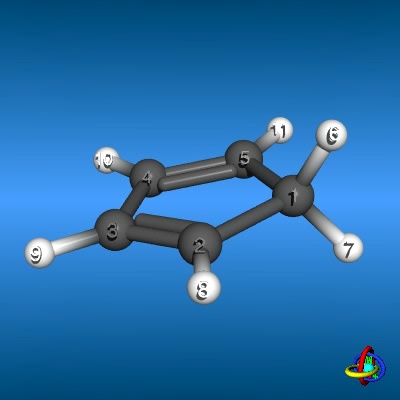 MOLecular ARCHitecture+ - MolArch+ Movies MOLecular ARCHitecture+ - MolArch+ Movies
|
This page gives an overview on different types of molecular animations
that were generated using the MolArch +
program.
|
 |
 1,5-H-Shift in Cyclopentadiene 1,5-H-Shift in Cyclopentadiene |
|
 1,5-H-Shift in 1,3-Pentadiene 1,5-H-Shift in 1,3-Pentadiene |
Many examples are known in which hydrogen atoms migrate from one end of a system of
p-bonds to the other end through pericyclic mechanisms ("sigmatropic" rearrengements
during which the C-H s-bond migrates within a system of
p-bonds). In these concerted processes, the hydrogen must, in the transition state, be
in contact with both ends of the p-system at the same time. In accordance with the
Woodward-Hoffmann rules for these reactions, the thermal 1,5-H-shift in 1,3-pentadiene is a suprafacial
process, and the hydrogen atom moves either along the top or the bottom side of the
p-system, but not across the corresponding plane of p-atoms
(the opposite would apply for the photochemically induced reaction). The transition state is of CS
symmetry and highly aromatic based on the geometric, energetic and magnetic criteria.
The animations on the left visualize the degenerate 1,5-H-shift for 1,3-pentadiene as
both the start and final geometries are identical.
|
|
|
|
 1,5-H-Shift in Cyclopentadiene 1,5-H-Shift in Cyclopentadiene |
|
 1,7-H-Shift in 1,3,5-Heptatriene 1,7-H-Shift in 1,3,5-Heptatriene |
In contrast to 1,5-H-shifts (see above), the corresponding thermal 1,7-H-shifts in 1,3,5-heptatrienes
are anatarfacial processes, in which the hydrogen atom must move across the plane of
p-atoms either from the top to the bottom of the p-systems
or vice versa; the transition state of this rearrangement is of C 2 symmetry and highly
delocalized with eight electrons. Unlike the Hückel aromatic transition states with
4 n + 2 electrons, thermally allowed transition structures
with 4 n delocalized electron are Möbius aromatics. The animations on the left display the
degenerate rearrangement for 1,3,5-heptatriene; for further details see H. Jiao, P. von R. Schleyer, "Aromaticity of pericyclic reaction
transition structures: magnetic evidence.", J. Phys. Org. Chem. 1998, 11, 655-662.
|
|
|
|
|
|